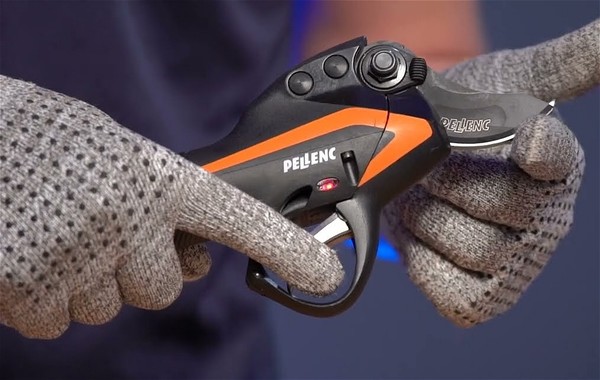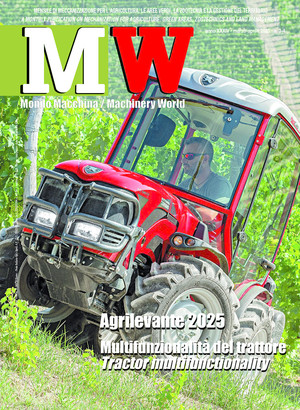
The safety of modern pruning shears
They are an essential aid for manual tree pruning, which unfortunately can cause accidents. Recent technological advancements, thanks to dedicated sensors and electronics, have made these tools much safer
Manual pruning of trees has undergone a remarkable evolution over the last 40 years, thanks to the introduction of shears and cutters powered by an external source of energy, whether hydraulic, pneumatic, or electric. In the latter case, battery power has also brilliantly solved the problem of portability and operating autonomy. The advent of electronics has finally enabled significant progress in operational efficiency, enabling, for example, the differentiated opening of the moving blade to cut branches and stems of different diameters with maximum speed and efficiency.
But it is in terms of safety that electronics has enabled a decisive "quantum leap" to be achieved. In addition to upper limb fatigue and, in the long term, the onset of carpal tunnel syndrome in the hand operating the tool, the most common risk in manual pruning is undoubtedly the more or less deep cuts caused by accidental contact of the fingers and the hand not involved in operating the shears. Such dangerous occurrences are unfortunately favored by the cumulative workload that inevitably builds up during the workday, leading to decreased attention and precision in movements. It is precisely this aspect that pruning shears manufacturers have recently focused on, developing particularly effective solutions that can solve the problem at its root.
Passive and active safety. Sturdy but flexible work gloves, made of wear-resistant material and with good thermal insulation, are the main form of personal protective equipment that can help reduce fatigue, while also preventing minor cuts and abrasions caused by rubbing against tree vegetation and, to a certain extent, reducing the severity of serious injuries caused by accidental contact with the moving blade of the pruning shears. However, it is on active safety, and in particular on the management of blade movements, that manufacturers have focused in order to reduce the aforementioned risk.
The strategies adopted involved various solutions. Initially, the progressive cutting function was introduced, whereby the movement of the moving blade closely follows that of the control trigger. In other words, whereas previously a single impulse was sufficient to make the blade perform the entire movement, now a continuous command ("dead man's switch") is required, which operationally allows the amplitude of the blade's excursion to be modulated according to the pressure exerted on the trigger. In this case, the additional significant advantage is that, in the event of accidental contact and cutting of the finger, the operator's normal pain reaction causes the trigger to be instinctively released, thus limiting damage. At this point, the blade immediately stops the closing movement towards the hinge, then in most cases moves to complete opening. This prevents amputations and/or fractures of the bone structure of the fingers, but does not prevent deep tissue injuries and lacerations or complete severing of nerves and tendons.
The contribution of sensors. Accident prevention technology has seen a significant improvement with the introduction of sensors, which are able to prevent the movement from starting if any part of the hand that is not engaged with the shears comes into contact with its structure. The physical principle on which the system is based is the variation in impedance (which in this case can be likened to electrical resistance) that occurs in the natural conductive circuit formed by the shears, and consequently by the hand holding them, the body and the other hand of the operator, when they accidentally touch a metal part (the blade, or even another element) of the shears themselves. In practice, the closure of the electrical circuit causes a reduction in resistance, which is detected by the passage of a minimal current, which in turn triggers the blade’s lock.
However, for the protection system illustrated to be as effective as possible, it is necessary to bear in mind certain precautions related to the variability of the operator's personal and environmental conditions. In fact, electrical resistance, which in this case can be considered the opposite of conductivity, varies significantly at an individual level, so prior "calibration," or adjustment to one's own specific characteristics, is necessary. Many manufacturers of shears equipped with this special function recommend activating the protection device by operating it and touching the tool before use with each of the fingers of the unoccupied hand, in order to store a personalized electrical resistance value, so that the circuit can be used to its maximum sensitivity.
However, it is also important to adequately assess the environmental conditions: pruning wet wood on the surface and/or in the presence of high ambient humidity can significantly alter the sensitivity of the circuit. In this situation, using the shears with bare hands is not the best solution, and it is therefore recommended to wear a pair of suitable gloves, which must be conductive. Gloves incorporating silver filament inserts or weaves are available for this purpose, which are able to stabilize the conductivity of the circuit created when accidental contact occurs. Even when using these types of gloves, it is advisable to perform the device calibration procedure described above.
What the market offers. All major manufacturers of electronic shears offer models equipped with protection against accidental cuts based on the variation in the state of the inductive circuit created in such an event. In addition to this device, some companies provide conductive gloves. For the C35, C45, and C3X models, Pellenc Italia in Colle val D'Elsa (SI) provides the "Activ' Security" system, a natural conductive circuit that causes the blade to stop immediately in case of contact with the user's finger, which must be expressly activated for maximum protection.
In its range of professional pruning shears, Zanon of Campodarsego (PD) includes the Viper SV 45 model, which comes with two gloves made of conductive fabric: when the blade accidentally comes into contact with the hand not holding the tool, the electronic system detects a variation in conductivity in the shear-blade-wood-to-be-cut-glove circuit, immediately intervening to block the blade’s closure. Additionally, the connection cable to the battery, whether belt or backpack-mounted, is covered with a bundle of conductive wires to prevent accidental cutting, thus avoiding a type of failure that is difficult to repair in the field.
On this subject, the French company Infaco offers an interesting range differentiated into three levels. All its models are equipped with the "DSES wireless" system, which consists of a conductive trigger capable of establishing a connection between the user's body and the electronic system of the shears, instantly reopening the blade if the cutting head of the tool comes into contact with the opposite hand. Although it is guaranteed to work in direct contact with the skin, the company recommends wearing conductive gloves, which reduce accidental activation on damp wood and/or too close to the ground. Alternatively, but with identical operating logic, there is the "wired DSES" option, which requires a dedicated conductive glove, directly connected to a specific power cable, capable of maintaining a secure physical connection with the shears.
The most interesting solution is the contactless DSES system, which anticipates the occurrence of potentially dangerous contact. This solution won several awards in 2024 at EIMA in Bologna and Vinitech in Bordeaux. It uses a transmitter in the glove and a receiver in the shears. In practice, a sort of "safety bubble" forms around the cutting head, so that when the hand not engaged with the tool enters the bubble (i.e., gets too close to the shears), the blade opens instantly. It is therefore an invisible protection, which allows pruning to be carried out in complete safety. Up to three safety zones can be defined, set directly on the shears or via the dedicated mobile app, depending on the size of the pruner's hand. The protective volume is oval in shape, designed to follow the natural curves of the hand and preserve the operator's working habits.
A system based on human physiology
This is a purely individual and highly variable value, which differs from person to person depending on a number of factors, including personal characteristics, environmental conditions, contact area and pressure, type of clothing worn, etc.
The human body is a collection of cells, composed largely of an aqueous saline solution, and an extracellular matrix between cells, both containing ions. From an electrical point of view, it can therefore be considered as a circuit characterized by a potential difference, defined as impedance, which varies according to the variables listed above.
The electrical resistance of the human body, which under certain conditions can be assimilated to impedance, also varies depending on the path of the current; it should be noted that the greatest resistance is recorded precisely in the path from one hand to the other.
The extent of contact also affects resistance, as does the presence of insulating material in the path of the current, such as gloves, socks, and other clothing items. The contact pressure must also be taken into account: intuitively, the higher the pressure, the lower the resistance encountered. In addition, the condition of the skin has a significant impact: moisture and especially sweat (which is water rich in salts, therefore an excellent conductor) but also cuts and abrasions contribute to reducing resistance.
Hence, there are multiple reasons why the most advanced electronic circuits designed to interrupt the blade's movement of pruning shears in the case of accidental contact with parts of the human body (which are based on monitoring the resistance of the skin between the two hands) require careful, diligent, and repeated calibration of the device, aimed at intervening effectively concerning predefined thresholds that can vary for each operator, but also depending on the individual environmental and personal conditions.








